Suvarnabhumi Airport
Suvarnabhumi Airport ท่าอากาศยานสุวรรณภูมิ | |||||||||||||||
|---|---|---|---|---|---|---|---|---|---|---|---|---|---|---|---|
| File:Suvarnabhumi Airport Logo.svg | |||||||||||||||
 | |||||||||||||||
| Summary | |||||||||||||||
| Airport type | Public | ||||||||||||||
| Operator | Airports of Thailand PLC (AOT) | ||||||||||||||
| Serves | Bangkok | ||||||||||||||
| Location | 999 moo 1 Tambon Racha Thewa, Amphoe Bang Phli, Samut Prakan, Thailand | ||||||||||||||
| Hub for | Asia Atlantic Airlines Bangkok Airways Business Air Jet Asia Airways Orient Thai Airlines Thai Airways International Thai Smile | ||||||||||||||
| Focus city for | Cathay Pacific China Airlines EVA Air SriLankan Airlines | ||||||||||||||
| Elevation AMSL | 5 ft / 2 m | ||||||||||||||
| Website | suvarnabhumiairport.com | ||||||||||||||
| Map | |||||||||||||||
Location in Samut Prakan Province, Greater Bangkok | |||||||||||||||
| Runways | |||||||||||||||
| |||||||||||||||
| Statistics (2015) | |||||||||||||||
| |||||||||||||||
Source: Airports of Thailand[2] | |||||||||||||||
Suvarnabhumi Airport (Thai: ท่าอากาศยานสุวรรณภูมิ; RTGS: Suwannaphum; pronounced [sù.wān.ná.pʰūːm] (Thai pronunciation); from Sanskrit, स्वर्णभूमि (IAST: Suvarṇabhūmi, "Golden Land"), (IATA: BKK, ICAO: VTBS), also known as (New) Bangkok International Airport, is one of two international airports serving Bangkok, Thailand. The other one is Don Mueang International Airport.[3][4]
Suvarnabhumi was officially opened for limited domestic flight service on 15 September 2006, and opened for most domestic and all international commercial flights on 28 September 2006.[5]
The airport is currently the main hub for Thai Airways International, Bangkok Airways and Orient Thai Airlines. It also serves as regional gateway and connecting point for various foreign carriers.
The airport is located on what had formerly been known as Nong Nguhao (Cobra Swamp) in Racha Thewa in Bang Phli, Samut Prakan, about 25 kilometres (16 mi) east of downtown Bangkok. The name Suvarnabhumi was chosen by King Bhumibol Adulyadej and refers to the golden kingdom, hypothesised to have been located somewhere in Southeast Asia.
The building was designed by Helmut Jahn of Murphy / Jahn Architects. It was constructed primarily by ITO JV. The airport has the world's tallest free-standing control tower (132.2 metres or 434 feet), and the world's fourth largest single-building airport terminal (563,000 square metres or 6,060,000 square feet).
Suvarnabhumi is the tenth busiest airport in the world, sixth busiest airport in Asia, and the busiest in the country, having handled 53 million passengers in 2012,[2] and is also a major air cargo hub, with a total of 95 airlines. On social networks, Suvarnabhumi is the world's most popular place where Instagram photographs were taken in 2012.[6]
The airport inherited the airport code, BKK, from Don Mueang after the older airport ceased international commercial flights. A modern motorway no.7 connects the airport, Bangkok, and the heavily industrial Eastern Seaboard of Thailand, where most of the manufacturing for export takes place.
History

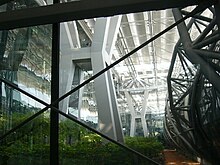
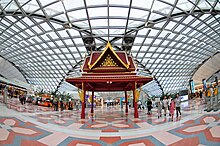




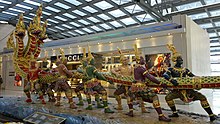
Land purchase, early construction
Planning of a second international airport for Bangkok started in the early 1960s. The process was slow from the start: as early as 1968, critics were already charging that the project was "five to seven years" behind the main schedule.[7]
The 32.4 square kilometres (12.5 sq mi)* plot of land occupied by the airport was purchased in 1973, but the student-led protests on 14 October that year led the overthrow of the military government of Prime Minister Thanom Kittikachorn and the project was shelved.[8] After a series of ups and downs, the "New Bangkok International Airport" company (NBIA) was formed in 1996. Due to political and economic instabilities, notably the Asian financial crisis of 1997, the civil construction began six years later in January 2002 by the government of Thaksin Shinawatra. The airport is located in a once low-lying marsh, formerly known as Nong Ngu Hao (Thai: หนองงูเห่า, lit. "Cobra Swamp"), which took five years (1997–2001) to clear make a land reclamation. In 2005, the construction supervision and management was transferred to the Airports of Thailand PLC, while the NBIA company was dissolved. [citation needed]
Early construction, airport tests, and official opening
The airport was due to open in late 2005, but a series of budget overruns, construction flaws, and allegations of corruption plagued the project.
A further delay was caused by the discovery that the airport had been built over an old graveyard, and superstitious construction workers claimed to have seen ghosts there. On 23 September 2005, the Thai airports authority held a ceremony where 99 Buddhist monks chanted to appease the spirits.[9]
Full tests of the airport took place on 3 and 29 July 2006. Six airlines – Thai Airways International, Nok Air, Thai Air Asia, Bangkok Airways, PBair, and One-Two-GO – used the airport as a base for twenty domestic flights.[10][11] The first international test flights were conducted on 1 September 2006. Two THAI's aircraft, Boeing 747-400 and Airbus A300-600, simultaneously departed the airport at 09:19 to Singapore and Hong Kong. At 15:50 the same aircraft flew back and made simultaneous touchdowns on runways 19L and 19R. These test flights demonstrated the readiness of the airport to handle heavy traffic. [citation needed]
On 15 September 2006, the airport started limited daily operations with Jetstar Asia Airways operating three Singapore to Bangkok flights 3K511.[clarification needed] The first commercial arrival Singapore flight 3K512 and Thai Airways International operating some domestic flights to Phitsanulok, Chiang Mai and Ubon Ratchathani. Bangkok Airways moved on 21 September, AirAsia and Thai AirAsia followed suit on 25 September and on 26 September Nok Air moved to Suvarnabhumi Airport. During this initial phase, as well as in the previous tests, the airport used the temporary IATA code NBK. [citation needed]
Suvarnabhumi officially opened at 03:00 on 28 September 2006, taking over all flights from Don Mueang. The first flight to arrive was Lufthansa Cargo flight LH8442 from Mumbai at 03:05.[12] The first commercial when officially opened arrival was from Japan Airlines at 03:30. The first passenger arrival was Aerosvit flight VV171 from Kiev at 04:30, and the first cargo departure was Saudi Arabian Airlines flight SV-984 to Riyadh at 05:00.[13] Aerosvit also had the first passenger departure (VV172 to Kiev) around 05:30.[14]
Initial difficulties
Many difficulties were recorded in the first few days of the airport's operation. On the first day alone, sluggish luggage claims were common – the very first passenger arrival by Aerosvit took an hour for the luggage to start coming out, and some flights did not have their luggage coming out even after four hours. Also flights were delayed (Thai Airways claimed that 17 of 19 flights were delayed that day), and there were also failures with the check-in system.[15][16] Subsequent problems included the failure of the cargo computer system, and the departure boards displaying the wrong information, resulting in confused passengers (especially as unlike Don Mueang, there were no "final calls" issued).[17]
Months into its opening, issues such as congestion, construction quality, signage, provision of facilities, and soil subsidence continued to plague the project, prompting calls to reopen Don Mueang to allow for repairs to be done.[18] Expert opinions varied widely regarding the extent of Suvarnabhumi's problems as well as their root cause; most airlines stated that damage to the airport was minimal.[19][20] Prime Minister Surayud Chulanont decided on 16 February 2007 to reopen Don Mueang for domestic flights on a voluntary basis, with 71 weekly flights moved back initially, with no international flights allowed.[21]
Capacity and safety issues
Tarmac problems
In January 2007, ruts were discovered in the runways at Suvarnabhumi.[22] The east runway was scheduled to close for repairs. Expert opinions have varied widely as to the root cause of the ruts.[19] Airport authorities and airline representatives maintained that the airport was still safe and resisted suggestions that the airport should be completely closed and all flights moved back to Don Muang.[23]
On 27 January 2007, however, the Department of Civil Aviation declined to renew the airport's safety certificate, which expired the previous day. The ICAO requires that international airports hold aerodrome safety certificates, but Suvarnabhumi will continue to operate because the ICAO requirement has yet to be adopted as part of Thai law.[24]
As of early-2016 tarmac problems persist at Suvarabhumi. Soft spots on the tarmac, taxiways and apron area have not been permanently fixed. Aircraft get stuck in the soft surfaces that are the result of sub-standard materials. "The constant resurfacing of the tarmac, taxiways and apron area with asphalt is an unacceptable patchwork solution. We literally need a "concrete" solution," said said Tony Tyler, IATA's director general and CEO.[25]
Plans to re-open Don Mueang for domestic flights
In January 2007, Thai Airways announced a plan to move some of its domestic operations back to Don Muang International Airport due to overcrowding. Three days later, the Ministry of Transport recommended temporarily reopening Don Muang while repair work on the runways at Suvarnabhumi proceeds. At that time, Thai Airways said it would shift most of its domestic flights back to Don Muang while keeping flights with high international passenger connections such as Chiang Mai and Phuket at Suvarnabhumi. On 28 March 2009, Thai Airways discontinued all domestic flights from Don Muang. Bangkok Airways and One-Two-GO had similar plans, but Bangkok Airways remained at Suvarnabhumi. Thai AirAsia said it would not move unless it could shift both its international and domestic operations, prompting them to stay at Suvarnabhumi for the time being. Nok Air and PBair were undecided, but Nok Air later relocated all their flights to Don Muang, where they operate today.[26][27] As of January 2010, only Nok Air and One-Two-Go operate domestic flights from Don Muang Airport. PBair have ceased operations altogether. One-Two-Go was integrated into Orient Thai Airlines in July 2010, but continues to operate from Don Muang Airport. As of 1 October 2012 Air Asia has moved all of its Bangkok operations to Don Muang International Airport (DMK) from Suvarnabhumi Airport (BKK).[28]

Repair and upgrades
Airports of Thailand found that the cost of fixing 60 identified problems at the airport would be less than 1% of the total airline cost and the problems could be fixed in up to four to five years. Dr. Narupol Chaiyut, a member of a committee overseeing service problems at the new airport, estimated that 70% of the problems would be fixed within 2007. Twenty of the 60 problems were successfully fixed by February 2007.[29]
Features
Suvarnabhumi Airport's main terminal roof is designed with structural elements and bays placed in a cantilevered, wavelike form to appear to "float" over the concourse beneath. This overall design principle was to express the former essence of the site, from which water had to be drained before construction could begin. The eight composite 2,710-ton trusses supporting the canopy of the main terminal are essentially diagrams of the bending moments acting on them, with the greatest depth at mid-span and over the supports.[30]
The result of Helmut Jahn's vision is a structure with performance materials serve in their total composition and in use more than in their conventional roles. This maximizes daylight use in comfort with substantial energy life-cycle cost savings. The installed cooling system reduced up to 50% compared to a conventional system. A translucent membrane with three layers was developed to mediate between the interior and exterior climate, dealing with noise and temperature transmission, while still allowing natural flow of daylight into building.[31]
Events
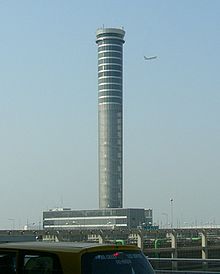
On 25 January 2007, due to work to the upgrading the taxiways, which suffered from small cracks, few incoming flights were delayed and several flights were safely diverted to a nearby operating U-Tapao International Airport in Rayong province.[32]
On 26 November 2008, an illegal occupation of the airport took place by People's Alliance for Democracy, closing the departure lounge and blocking exits and causing almost three thousand passengers stranded within the main terminal, another 350,000 were stranded inside the country, as all flights were grounded for a short while. The People's Alliance for Democracy seized the control tower at 12:00 am.[33] On 2 December 2008, protesters agreed to leave the airport as they had been illegally protesting and permitted the resumption of flights. Security checks, clean-ups and re-certification once the illegal occupation ended delayed the airport from being fully functional until 5 December 2008.[34]
Predatory irregularities
Petty thieves and confidence men, the majority of them illegal taxi drivers or tour guides, are known to prey on tourists in the arrival hall. They belong to politically-well connected criminal groups: Kamnan Samruay, Boonruang Srisang, Sak Pakphanang, the Pattaya Mafia and Phuyai Daeng.[35] Evicting them has proved difficult as they allegedly are well connected. (The head of the Pirap gang is supposedly related to an Airports of Thailand executive, while the Phuyai Daeng has ties to influential civil servants in Samut Prakan.)[35]
On 1 October 2010, two hundred armed men occupied the airport's parking area for an hour, blocking the building's entrances and seizing ticket booths to collect fares from motorists.[36] Airport security personnel failed to respond, reportedly because of an internal dispute within the Parking Management Company, the firm contracted to run the parking facilities.[36]
Specifications

Costing an estimated ฿155 billion (US$5 billion), the airport has two parallel runways (60 m wide, 4,000 m and 3,700 m long) and two parallel taxiways to accommodate simultaneous departures and arrivals.[37] It has a total of 120 parking bays (51 with contact gates and 69 remote gates), with five of these capable of accommodating the Airbus A380. The main passenger terminal building, with a capacity of handling 76 flight operations per hour, co-locates the international and domestic terminals, though assigning them to different parts of the concourse. In the initial phase of construction, it will be capable of handling 45 million passengers and 3 million tonnes of cargo per year. Above the underground rail link station and in front of the passenger terminal building is a 600-room hotel operated by Accor Group under the Novotel brand.
The airport's passenger terminal is the world's largest passenger terminal ever constructed in one phase at 563,000 square metres (6,060,000 sq ft), and is also currently the fourth biggest passenger terminal building in the world, after the Hong Kong International Airport (570,000 square metres or 6,100,000 square feet), Beijing Capital International Airport (990,000 square metres or 10,700,000 square feet), with the largest passenger terminal being at Dubai International Airport (Terminal 3 is over 1,500,000 square metres or 16,000,000 square feet). The airport air-traffic control tower is the tallest in world history at 135 metres (443 ft). [citation needed]
Suvarnabhumi Airport has 72 jet bridges and 69 non-jet bridges. Additionally, flights are also able to park at remote locations on the ramp, from which airport buses transport passengers to and from the terminal. Suvarnabhumi Airport has 18 jet bridges and 6 non-jet bridges for Airbus 380–800 [citation needed]
Expansion
On 15 December 2011 Airports of Thailand (AOT) announced the speed up of the second phase expansion of Suvarnabhumi Airport to 2016, one year ahead of its scheduled completion in 2017.
An investment of 62.5 billion baht (US$1.95 billion/€1.49 billion) is being planned for the second phase, according to then Transport Minister Sukampol Suwannathat. The plan is to strengthen Suvarnabhumi Airport's position as a regional aviation hub. Phase Two would raise the airport's capacity to 65 million passengers a year and should also be undertaken in parallel with the construction of the new domestic terminal.[38]
Earlier transport Minister ACM Sukampol Suwannathat gave the green light to Airports of Thailand (AoT)'s plan to carry out the expansion of Suvarnabhumi airport with the construction of a new domestic terminal. The new domestic terminal will be capable of handling 20 million passengers a year. Estimated cost is 9.2 billion Baht.(US$2.96 billion/€2.04 billion). [citation needed]
By mid-2015, the airport was handling more than 800 flights per day, higher than its 600-flight capacity and has exceeded its capacity of 45 million passengers per year.[39]
The two expansion projects are part of the overall airport enlargement that would see Suvarnabhumi raise its annual passenger handling capacity to 125 million passengers, 90 million international and 35 million domestic passengers by 2024 at an estimated cost of 163 billion baht.($5.25 billion USD/€3.62 billion EURO) The expansion includes the construction of one additional runway from two at the present, subsequent enlargement of domestic and international terminals and improvements to parking bays, car parks, and other airport infrastructure.[40]
An expansion plan to increase the passenger capacity of the airport to 65 million by building an additional satellite passenger terminal linked to the current main terminal via an underground automated people mover (APM) system is set to be voted on by the AOT board during a 17 May 2012 meeting. If the plan gains endorsement by the board it will be able to proceed to appointing a project management consultant (PMC) which will bring it one step closer to commencing construction on the much needed expansion. If all goes to plan the expansion is set to be completed in 2018. The expansion also includes a plan to expand the airport parking garage as well as the expansion of the eastern end of the main passenger terminal by 135 meters along with the construction of a new airline office building. The expansion does not include plans to construct a third runway, however. According to the Bangkok Post, the new satellite terminal will have a total of 28 gates, with 8 for the Airbus A380 superjumbo jet.[41]
The new passenger terminal will be used only by Bangkok Airways and flag carrier Thai Airways International. Furthermore, the airport wants to cluster the airlines belonging to an alliance.[42]
Airlines and destinations
Passenger
Cargo
Traffic and statistics
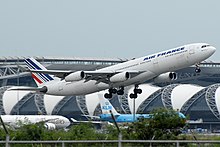









Busiest international routes
| Rank | Airport | Passengers handled 2014 | % Change 2013/14 |
|---|---|---|---|
| 1 | Hong Kong | 3,020,742 | |
| 2 | Singapore | 2,612,113 | |
| 3 | Seoul-Incheon | 1,907,423 | |
| 4 | Dubai-International | 1,388,486 | |
| 5 | Tokyo-Narita | 1,289,104 | |
| 6 | Taipei-Taoyuan | 1,113,418 | |
| 7 | Shanghai-Pudong | 962,177 | |
| 8 | Kuala Lumpur–International | 868,887 | |
| 9 | Tokyo-Haneda | 816,968 | |
| 10 | Guangzhou | 752,345 |
Busiest domestic routes
| Rank | Airport | Passengers handled 2013 | % Change 2012/13 |
Passengers Handled 2012 |
|---|---|---|---|---|
| 1 | Phuket | 2,469,226 | 3,302,196 | |
| 2 | Chiang Mai | 1,948,297 | 2,552,333 | |
| 3 | Samui | 1,198,434 | 1,426,247 | |
| 4 | Krabi | 601,303 | 724,856 | |
| 5 | Khon Kaen | 555,597 | 513,612 | |
| 6 | Hatyai | 432,525 | 1,047,850 | |
| 7 | Chiang Rai | 396,072 | 665,263 | |
| 8 | Udon Thani | 312,126 | 563,946 | |
| 9 | Surathani | 163,599 | 383,160 | |
| 10 | Ubon Ratchathani | 154,461 | 330,834 |
Traffic by calendar year
Suvarnabhumi accounted for the largest share of air traffic at Thailand's airports in 2015, handling 52.9 million passengers, up by nearly 14 percent from the previous year despite its passenger capacity of only 45 million a year. International passengers passing through Suvarnabhumi grew 15.9 percent to 44.2 million, while domestic volume edged up 4.87 percent to 8.68 million. Aircraft movements showed a 9.50 percent increase to 317,066, consisting of 247,584 international (up 11 percent) and 69,482 domestic (up 4.41 percent).[80]
| Passengers | Change from previous year | Movements | Cargo (tons) | |
|---|---|---|---|---|
| 2008 | 38,603,490 | – | – | 1,173,084 |
| 2009 | 40,500,224 | – | 1,045,194 | |
| 2010 | 42,784,967 | – | 1,310,146 | |
| 2011 | 47,910,744 | 299,566 | – | |
| 2012* | 53,002,328 | 312,493 | – | |
| 2013 | 51,363,451 | 288,004 | 1,236,223 | |
| 2014 | 46,423,352 | 289,568 | 1,234,176 | |
| 2015 | 52,902,110 | 317,066 | 1,230,563 | |
| Source: Airports Council International[81] Note : * In 2012, the government enjoined all low-cost airlines to move their hubs to DMK within October | ||||
Ground transportation

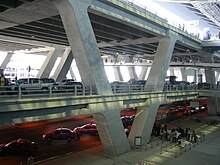
Airport Rail Link
The 30-billion baht Suvarnabhumi Airport Link was opened on 23 August 2010,[82] after multiple delays. The Airport Rail Link (ARL) is operated by SRTET, a subsidiary company of the State Railway of Thailand. The standard gauge line is 28.6 kilometers long and is elevated for most its length, running mostly above existing regional railway lines and parallel to the No. 7 Motorway and Si Rat Expressway. There is a short at-grade/underground segment as the line approaches the passenger terminal building of Suvarnabhumi Airport.
The ARL hours of service are 06.00 to 24.00.[83] The ARL has two interchange stations, namely Phaya Thai (changing for BTS Green Line services) and Makkasan (linking Phetchaburi station of the MRT Blue Line). In the future, the ARL will complement the SRT Red Line commuter service, which comprises two-meter gauge, dual-track lines. The ARL may also be extended from Phaya Thai to Don Mueang via Bang Sue, given that the old Don Mueang International Airport has now been reopened for civil aviation under a dual-airport policy.
Regional train
Meanwhile, SRT provides a suburban commuter train service between Lad Krabang (the nearest station to Suvarnabhumi on the East line, one station from the airport by Airport Rail Link) and the northern suburban city of Rangsit via downtown Bangkok and the old Don Mueang Airport. The train also connects with BTS and MRT at Phaya Thai and Phetchaburi stations respectively. A shuttle bus service linking the airport with Hua Takhe railway station is provided by BMTA. The train service is currently not as popular as the bus service because it requires a shuttle bus connection. The service will be stopped when the Airport Express Link is completed. [citation needed]
Bus
A free bus service connecting Suvarnabhumi Airport and Don Mueang Airport operates from 05.00 until midnight. Three air-conditioned city bus routes are operated by Bangkok Mass Transit Authority (BMTA) serve the airport's dedicated bus terminal
Automobile
The airport has five main access routes. Among these the most convenient route is via the Bangkok Chon Buri Motorway (Highway No. 7). Another main airport entrance is in Samut Prakan province via the expressway from Bang Na to Bang Pakong.
The airport has provided five convenient entrance routes. The main route is via the motorway in the north of Bangkok, directly connecting Bangkok's downtown and Chon Buri province, the industrial and harbor city in eastern Thailand. However, another main airport entrance is located in Samut Prakan province, connecting an elevated highway in the south of Bangkok which lies from Bang Na to Bang Pakong.
References
- ^ a b "Bangkok Suvarnabhumi airport – Economic and social impact". Ecquants. Retrieved 7 September 2013.
- ^ a b 2011 Statistics
- ^ "Don Mueang to be city budget air hub". Bankgok Post. Retrieved 2 July 2013.
- ^ "AirAsia to shift to Don Mueang". Retrieved 2 July 2013.
- ^ USA Today, "Bangkok's new airport opens to first commercial flights", USA Today, 15 September 2006.
- ^ Bangkok Post, "Suvarnabhumi, Paragon top Instagram places list". Bangkok Post, 29 December 2012.
- ^ "New airport to be ready on time" [1], Bangkok Post, 5 November 1968. Template:Wayback
- ^ Handley, Paul M. (2006). The King Never Smiles. Yale University Press, ISBN 0-300-10682-3.
- ^ Richard Lloyd Parry, "Poo Ming – a blue ghost who haunts $4bn airport", The Times, 27 September 2006
- ^ ThaiDay, "THAI discounts tickets for historic test flights", 1 July 2006.
- ^ "PM Thaksin says Suvarnabhumi Airport ready in two months", MCOT, 29 July 2006. Template:Wayback
- ^ Pennapa Hongthong, Just listen to our noisy nightmare, The Nation, 28 September 2006
- ^ Petchanet Pratruangkrai, Suchat Sritama, Exporters pan new export fees, The Nation, 27 September 2006
- ^ Kurt Hofmann, LH Cargo set to be first into Suvarnabhumi, ATW, 28 September 2006
- ^ Suchat Sritma, Touch down...into chaos, 29 September 2006
- ^ e-Travel Blackboard, Baggage ruffles up some feathers, but Suvarnabhumi still a success, 29 September 2006
- ^ The Nation, Airport shippers hit by computer failure, 2 October 2006
- ^ Some flight services will likely return the Don Muang Airport, The Nation, 29 January 2007. Template:Wayback
- ^ a b The Nation, Engineers unable to agree on root cause of airport cracks, 10 February 2007
- ^ The Nation, THAI baulks at moving to Don Muang, 15 February 2007
- ^ Thailand backtracks on plan for second international airport, Channel NewsAsia, 16 February 2007
- ^ A Rough Takeoff for Bangkok's New Airport, Time, 25 January 2007
- ^ New airport's east runway to close for repairs, return to Don Muang mooted, Thai News Agency, MCOT, 27 January 2007. Template:Wayback
- ^ "Bangkok airport officially unsafe", CNN, 27 January 2007 Template:Wayback
- ^ "Thailand needs to do more for higher aviation competitiveness: IATA". The Nation. 18 February 2016. Retrieved 18 February 2016.
- ^ Use Don Muang during repairs: 2 airlines, The Nation, 27 January 2007.
- ^ Move to use 2 airports gets mixed reception, The Nation, 31 January 2007.
- ^ AirAsia moves to Don Mueang Airport (1 October 2012), Air Asia, 13 August 2012.
- ^ B1bn needed to fix terminal problems over four to five years[dead link], Bangkok Post, 16 February 2007
- ^ University of Cincinnati, SUVARNABHUMI AIRPORT, September 2008
- ^ E-Architect, Suvarnabhumi Airport Bangkok, 15 August 2008
- ^ Some airlines afraid to use new airport, The Nation, 26 January 2007.
- ^ "BBC NEWS - Asia-Pacific - Thai protesters shut down airport". Retrieved 3 June 2015.
- ^ Agence France-Presse. "(Update) Thai protesters agree to clear airport: protest leader". ABS-CBN News. Retrieved 3 June 2015.
- ^ a b "Crackdown fails to stop airport gangs". Bangkok Post 6 September 2009
- ^ a b "AoT orders firm to end dispute after car park seizure". Bangkok Post 2 October 2010
- ^ Bangkok Post, New Bangkok Airport – Now Aiming For July 2006 Opening, 2005
- ^ "2nd phase development to be finished one year ahead". The Nation. 15 December 2011. Retrieved 3 June 2015.
- ^ Sritama, Suchat (24 May 2015). "Open-sky policy must continue, say airlines". The Sunday Nation. Retrieved 24 May 2015.
- ^ Bangkok Post, Minister supports airport expansion, 30 August 2011.
- ^ Bangkok Post, Suvarnabhumi expansion advances, 27 April 2012.
- ^ http://www.bangkokpost.com/news/general/470682/home-comforts-for-airlines
- ^ http://airlineroute.net/2015/12/08/uu-w16update2/
- ^ "Air China Adds Hangzhou - Bangkok Service from mid-June 2015". Airlineroute.net. 7 April 2015. Retrieved 7 April 2015.
- ^ "Air China Adds Tianjin – Bangkok Route from late-July 2015". Airlineroute.net. 30 June 2015. Retrieved 30 June 2015.
- ^ "Bangkok Airways Revises Planned Da Nang Launch to late-May 2016". airlineroute. Retrieved 25 February 2016.
- ^ "Capital Airlines Adds Zhanjiang – Bangkok Service from late-Oct 2015". Airlineroute.net. 7 October 2015. Retrieved 7 October 2015.
- ^ a b "China Eastern Adds New Bangkok Service in 16Q1". airlineroute. Retrieved 26 January 2016.
- ^ a b http://airlineroute.net/2015/12/08/cz-lhwbkk-jan16/
- ^ "Chongqing Airlines Schedules International Debut in early-Feb 2016". airlineroute. Retrieved 28 January 2016.
- ^ "Eastarjet Adds Jeju - Bangkok Flights from Oct 2015". Airlineroute.net. 8 September 2015. Retrieved 8 September 2015.
- ^ "Eurowings Changes to Bangkok Operations". airlineroute. Retrieved 29 June 2015.
- ^ http://airlineroute.net/2016/03/04/9w-sgn-s16cxld/
- ^ http://airlineroute.net/2015/12/25/lv-jan16/
- ^ "Myanmar National Airlines Adds Bangkok Service from late-Jan 2016". airlineroute. Retrieved 30 December 2015.
- ^ "Nordwind - Home". Retrieved 3 June 2015.
- ^ "Новое направление – из Архангельска в Бангкок". ОАО "Аэропорт "Архангельск". Retrieved 17 September 2013.
- ^ http://airlineroute.net/2016/02/09/rj-can-s16/
- ^ "S7 Airlines Adds Vladivostok – Bangkok Flights in W16". airlineroute. Retrieved 29 February 2016.
- ^ S7757 schedule. (S7 Airlines flight: Krasnoyarsk -> Bangkok). Info.flightmapper.net. Retrieved on 25 August 2013.
- ^ S7860 schedule. (S7 Airlines flight: Bangkok -> Novosibirsk). Info.flightmapper.net. Retrieved on 25 August 2013.
- ^ "Shenzhen Airlines Expands Bangkok Operation from Jan 2016". Airlineroute.net. 20 October 2015. Retrieved 20 October 2015.
- ^ "Shanezhen Airlines Adds Guangzhou - Bangkok Service in Sep/Oct 2015". Airlineroute.net. 20 August 2015. Retrieved 20 August 2015.
- ^ "Sichuan Airlines Adds Chengdu – Bangkok Route from late-Oct 2015". airlineroute.net. Retrieved 16 September 2015.
- ^ "Sichuan Airlines Adds New China – Thailand Routes in July/August 2015". airlineroute. Retrieved 14 July 2015.
- ^ http://www.financialexpress.com/article/industry/companies/spicejet-flights-airline-says-now-fly-directly-chennai-to-bangkok-to-start-dec-10-2015/160990/
- ^ a b c d "Spring Airlines Adds New Thailand Service in W15". Airlineroute.net. 7 October 2015. Retrieved 7 October 2015.
- ^ "Spring Airlines Expands Bangkok Service from late-May 2015". Retrieved 3 June 2015.
- ^ http://www.travelquotidiano.com/trasporti/thai-airways-conferma-i-voli-da-roma-dal-1-febbraio/tqid-231836.
{{cite web}}: Missing or empty|title=(help) - ^ http://airlineroute.net/2015/12/21/tg-fco-feb16/.
{{cite web}}: Missing or empty|title=(help) - ^ http://www.flyuia.com/eng/information-and-services/destinations/timetable.html
- ^ L, J (17 September 2015). "Ural Airlines to Adds New Beijing – Bangkok Service from late-Oct 2015". Airline Route. Retrieved 17 September 2015.
- ^ a b http://airlineroute.net/2015/08/26/u6-cgqbkk-w15/
- ^ "Xiamen Airlines New International Routes from Quanzhou from June 2015". Retrieved 3 June 2015.
- ^ "2013 summer schedule". Aero Logic. Retrieved 13 August 2013.
- ^ EVA Air Cargo Schedule
- ^ MP Cargo winter 2012 timetable
- ^ Turkish Airlines Cargo Winter Schedule
- ^ [2]
- ^ Kositchotethana, Boonsong (1 February 2016). "AoT airports set new record in passenger traffic". Bangkok Post. Retrieved 1 February 2016.
- ^ "Passenger Traffic 2010 FINAL". Airports Council International. 1 August 2012. Retrieved 29 April 2012.
- ^ "Airport Link to start commercial operation Aug 23". Mcot.net. Retrieved 10 February 2012.
- ^ http://www.suvarnabhumiairport.com/en/121-airport-rail-link
External links
![]() Media related to Suvarnabhumi International Airport at Wikimedia Commons
Media related to Suvarnabhumi International Airport at Wikimedia Commons
![]() Suvarnabhumi Airport travel guide from Wikivoyage
Suvarnabhumi Airport travel guide from Wikivoyage
- Suvarnabhumi Airport, Official site
- Free Zone by Suvarnabhumi Airport Website
- Airports of Thailand Public Company Limited and the page of the Suvarnabhumi Airport
- Suvarnabhumi Airport Project information from Airport Technology
- Current weather for VTBS at NOAA/NWS


